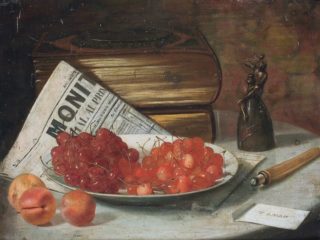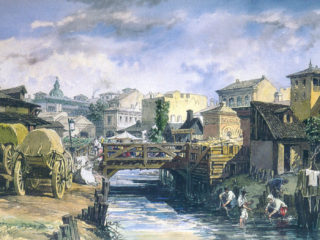For any woman born and raised in Romania, having owned or at least worn an ia—the traditional Romanian blouse—at some point in their life is something of a given. It is, by far, the most representative item of clothing of the traditional costume as we know it. In the villages that strive to preserve tradition—fewer and fewer, unfortunately— grandmothers, mothers, and even young girls, are sure to have a few traditional shirts in their dowry chest. Due to its rich history, ia is not just a garment anymore, it has become a symbol of Romanian culture and authenticity.
Ia: A Bit of History
Ethnologists and etymologists cannot agree upon the origin of the term ie (or ia with the definite article); while most suggest that it derives from the Latin tunicae liniae (a straight tunic), others insist that is comes from linum (flax). However, it is commonly accepted that today ia only denotes the shirts worn by women.
Although it is hard to tell precisely when ia started being part of the ethnic costume, it is believed to be at some point in the Neolithic, during the Cucuteni–Trypillia culture (c. 5200 to 3500 BC). Originally a festive pieces of clothing, ia has a simple cut and it’s usually white, made of flax, hemp, cotton or silk, over which geometrical or floral motifs are embroidered in coloured threads. It is worth mentioning as well that the motifs differ from one region to another, and each blouse tells a story of its own. Each item is handloom woven and embroidered or beaded by hand and it can take up to several weeks to finish one ia, depending on the complexity of the model.
Ambassadors of La blouse roumaine
One of the first ambassadors of the modern-era ia was Queen Marie of Romania. Born into the British Royal family, she became queen in 1922 by marrying Ferdinand I of Romania. She was definitely neither the first nor the only royal figure who sported the shirt, but she loved it so dearly—the whole ethnic costume, and everything connected to Romanian traditions—that she turned it into a personal fashion style. In many photographs and films of the interwar period she is depicted wearing both the traditional costume and also outfits inspired by it, that were considered more appropriate for royal etiquette. Following in the footsteps of Queen Marie, many members of the aristocracy of the time embraced the ethnic costume.
But probably the most renowned ambassador—without even intending to be one—was French painter Henri Matisse. Coming from a family of merchants and weavers, he had always been interested in fabrics, but it was a gift from his Romanian friend and fellow painter Theodor Pallady that sparkled his interest in the traditional blouse. Pallady offered Matisse a few shirts which the latter subsequently used in many sketches and paintings, of which the most famous remains La blouse roumaine (1940), held at the Musée National d’Art Moderne in Paris. As a token of respect, Matisse donated a few sketches of this painting to the Romanian people, sketches that are now in the possession of the National Museum of Art of Romania, but which are, unfortunately, rarely exhibited. Although Matisse’s painting is as famous as it can be, we can’t, obviously, miss the opportunity of mentioning some of the many Romanian painters who depicted ia in their works: C.D. Rosenthal, Theodor Aman, Nicolae Grigorescu, Nicolae Tonitza, Gheorghe Tattarescu, and others.
La Blouse Roumaine in Today’s Fashion
Being such a versatile item of clothing, it’s no wonder fashion designers around the world were inspired by it and used Romanian ethnic influences in their collections. In 1981, Yves Saint-Laurent first introduced the Romanian traditional shirt to the world in his fall collection. Later, in 1999, he dedicated his whole fall-winter collection—titled La blouse roumaine— to the traditional shirt. He said:
A Romanian blouse does not belong to any period. All the peasant clothes are passed down from century to century without going out of fashion.
Afterwards, many well-known designers, such as Oscar de la Renta, Jean Paul Gaultier, Tom Ford, Carolina Herrera or Isabel Marant followed suit, by reinterpreting the blouse in different ways. Not to mention Romanian fashion designers such as Adrian Oianu, Dana Budeanu, Dorin Negrău or Ingrid Vlasov, set on advocating Romanian folklore through their creations.
Ia: A Legacy
Established in 2012, La blouse roumaine is an online community determined to promote ia as a cultural brand. Starting with 2013, each June, on the 24th—the day of Sânziene, the Romanian equivalent of Midsummer—people are encouraged to celebrate by wearing the blouse, taking photos, share them on social media, and basically making it more visible, in an attempt to turn this day into an official Romanian Blouse Day. Taking things a step further, the first issue of the magazine La blouse roumaine is expected this December.
Another important initiative of the community was creating the #GiveCredit campaign, in order for fashion giants to credit the artisans from which they get inspiration—or rather steal, as it often happens, with fashion names like Vuitton, Valentino or Tori Burch presenting traditional designs from all over the world as their original ideas. Most recently, in the 2017 pre-fall collection, Dior introduced a vest—which they sold for 30.000 euro—that looks identical to traditional sheepskin vests worn in Bihor, NW Romania. As a result, Romanian fashion magazine Beau Monde created bihorcouture.com, a website meant to support authentic Romanian design, where people all over the world can buy—for a fraction of the Dior price— authentic Romanian clothes and accessories, designed and crafted by local artisans from Bihor.
And last but not least, having the clear mission of preserving, collecting, researching, and sharing the collection—with both the public and the specialists—the first Romanian Textile Museum, located in Băița, Hunedoara county, was opened in 2018. The museum is the labour of love of Florica Zaharia, who holds a PhD in textiles and is a Conservator Emerita of the Metropolitan Museum of Art in New York, where she worked for almost 30 years, until 2017. The collection includes textiles and tools from Romania, as well as many other parts of the world, with a focus on Eastern and Central European textiles and their connected technologies.
Featured image: Adina Voicu / pixabay











1 comment
Your work is WONDERFUL – I totally appreciate it